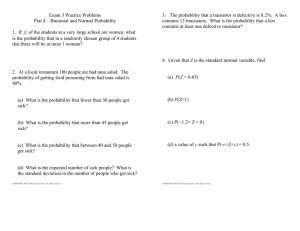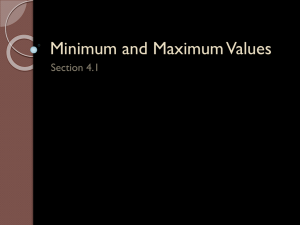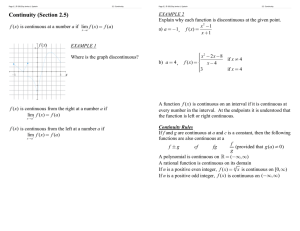Document 10413681
advertisement
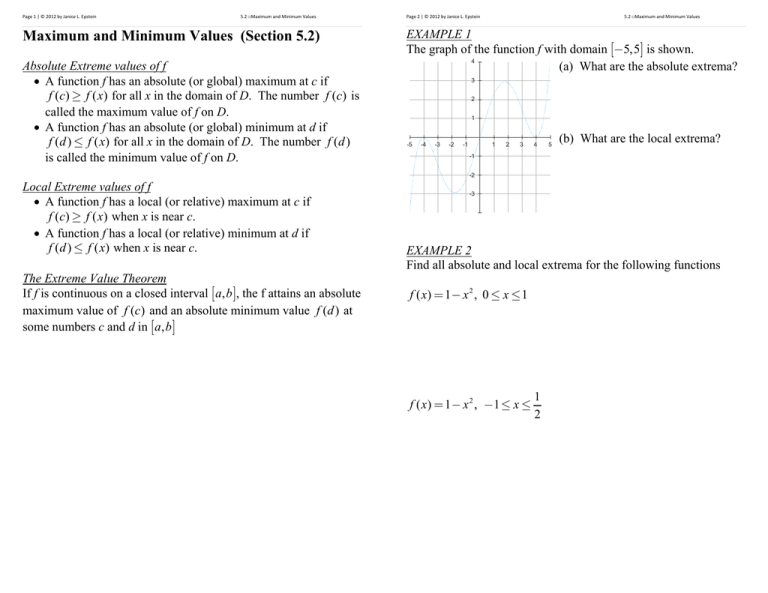
Page 1 | © 2012 by Janice L. Epstein 5.2 □Maximum and Minimum Values Maximum and Minimum Values (Section 5.2) Absolute Extreme values of f A function f has an absolute (or global) maximum at c if f (c) ³ f ( x) for all x in the domain of D. The number f (c) is called the maximum value of f on D. A function f has an absolute (or global) minimum at d if f (d ) £ f ( x) for all x in the domain of D. The number f (d ) is called the minimum value of f on D. Page 2 | © 2012 by Janice L. Epstein 5.2 □Maximum and Minimum Values EXAMPLE 1 The graph of the function f with domain [-5,5] is shown. 4 (a) What are the absolute extrema? 3 2 1 -5 -4 -3 -2 -1 1 2 3 4 5 (b) What are the local extrema? -1 -2 Local Extreme values of f A function f has a local (or relative) maximum at c if f (c) ³ f ( x) when x is near c. A function f has a local (or relative) minimum at d if f (d ) £ f ( x) when x is near c. The Extreme Value Theorem If f is continuous on a closed interval [ a, b ], the f attains an absolute maximum value of f (c) and an absolute minimum value f (d ) at some numbers c and d in [ a, b ] -3 EXAMPLE 2 Find all absolute and local extrema for the following functions f ( x ) = 1- x 2 , 0 £ x £ 1 f ( x ) = 1 - x 2 , -1 £ x £ 1 2 Page 3 | © 2012 by Janice L. Epstein 5.2 □Maximum and Minimum Values 1 f ( x) = , 0 < x < 1 x Page 4 | © 2012 by Janice L. Epstein for -1 £ x < 0 for 0 £ x £ 1 f ( x ) = x 2 -1 Fermat’s Theorem If f has a local maximum or minimum at c, and if f ¢(c) exists, then f ¢ (c ) = 0 . f ( x) = x +1 x + x +1 2 2 2 1 1 -2 -1 1 2 f ( x) = x + sin x -1 -2 -1 1 2 5.2 □Maximum and Minimum Values EXAMPLE 3 Find all critical numbers for the following functions f ( x ) = x 3 + 6 x 2 + 3 x -1 ìï x 2 f ( x) = íï 2 ï ï î2 - x -2 f ( x) = xe2 x Critical Numbers A critical number (or value) of a function f is a number c in the domain of f such that either f ¢(c) = 0 or f ¢(c) does not exist. f ( x) = 3 x 2 - x Page 5 | © 2012 by Janice L. Epstein 5.2 □Maximum and Minimum Values Finding Absolute Extrema To find the absolute extrema of a continuous function f on a closed interval [a, b] , 1. Find all critical values c1, c2, etc of f in the interval (a, b) Page 6 | © 2012 by Janice L. Epstein iv. f ( x) = x - 2cos x, [-p, p ] v. f ( x) = x , [1, 2] x +1 vi. f ( x) = x , [-2, 2] x +1 vii. f ( x) = ln x , [1,3] x 2. Find the values of f (c1 ), f (c2 ) etc along with f (a ) and f (b) 3. The absolute maxima is the largest of the values found in steps 1 and 2. 4. The absolute minima is the smallest of the values found in steps 1 and 2. EXAMPLE 4 Find the absolute extrema for the following functions i. f ( x) = x3 -12 x + 1, [-3,5] ii. f ( x) = -x + 27 x + 1, [0, 4] iii. f ( x) = x - 2cos x, [0, p ] 3 5.2 □Maximum and Minimum Values
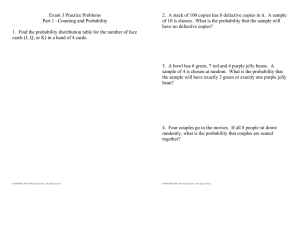
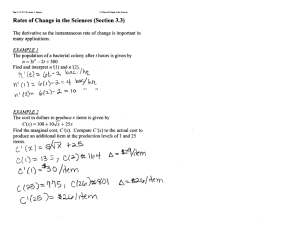
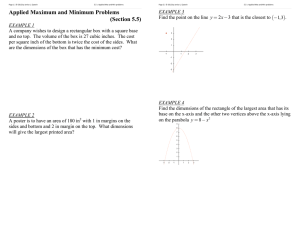


![Area (Section 6.2) [ ]](http://s2.studylib.net/store/data/010413671_1-efe902d3637e0ae3939f101c43978461-300x300.png)

